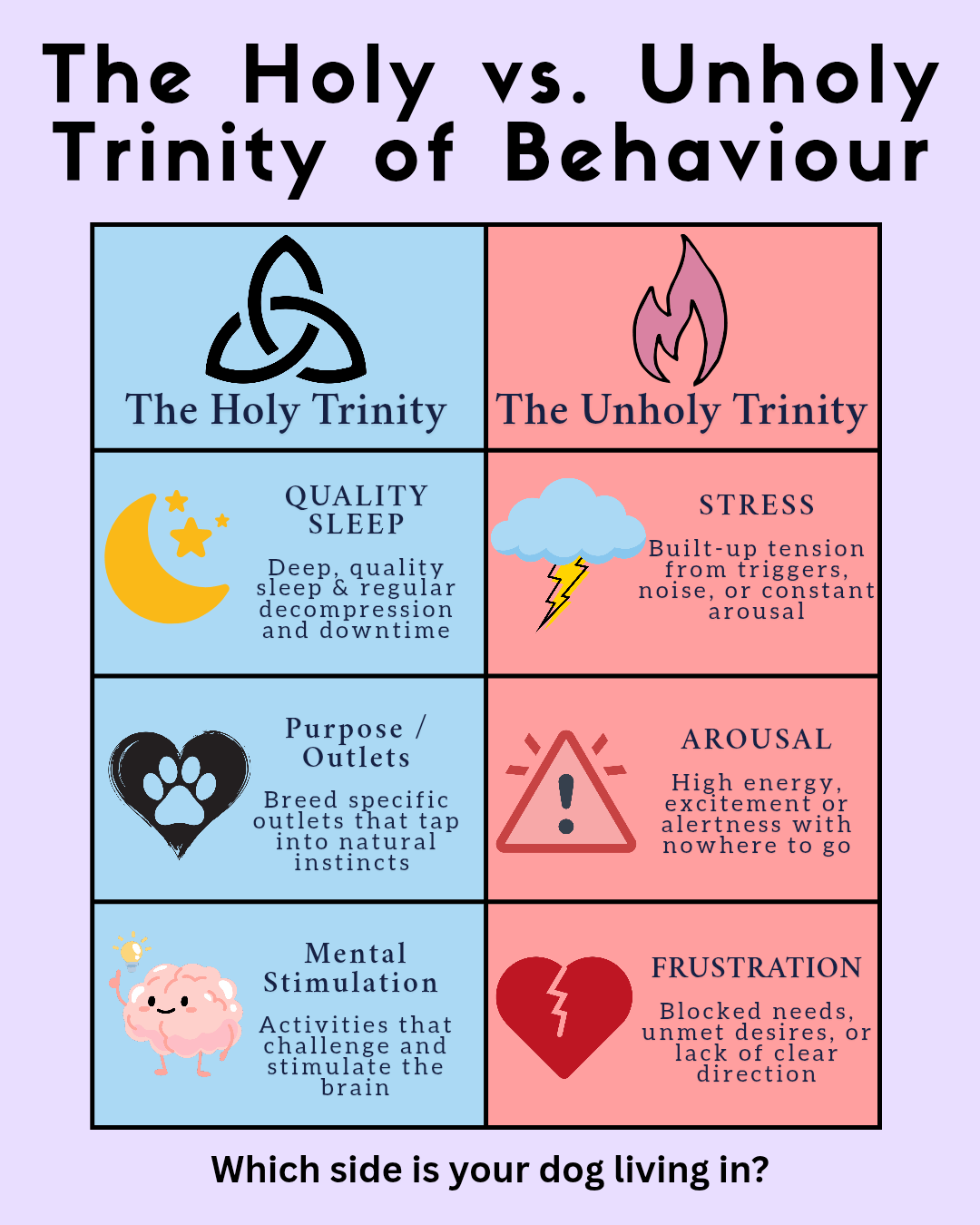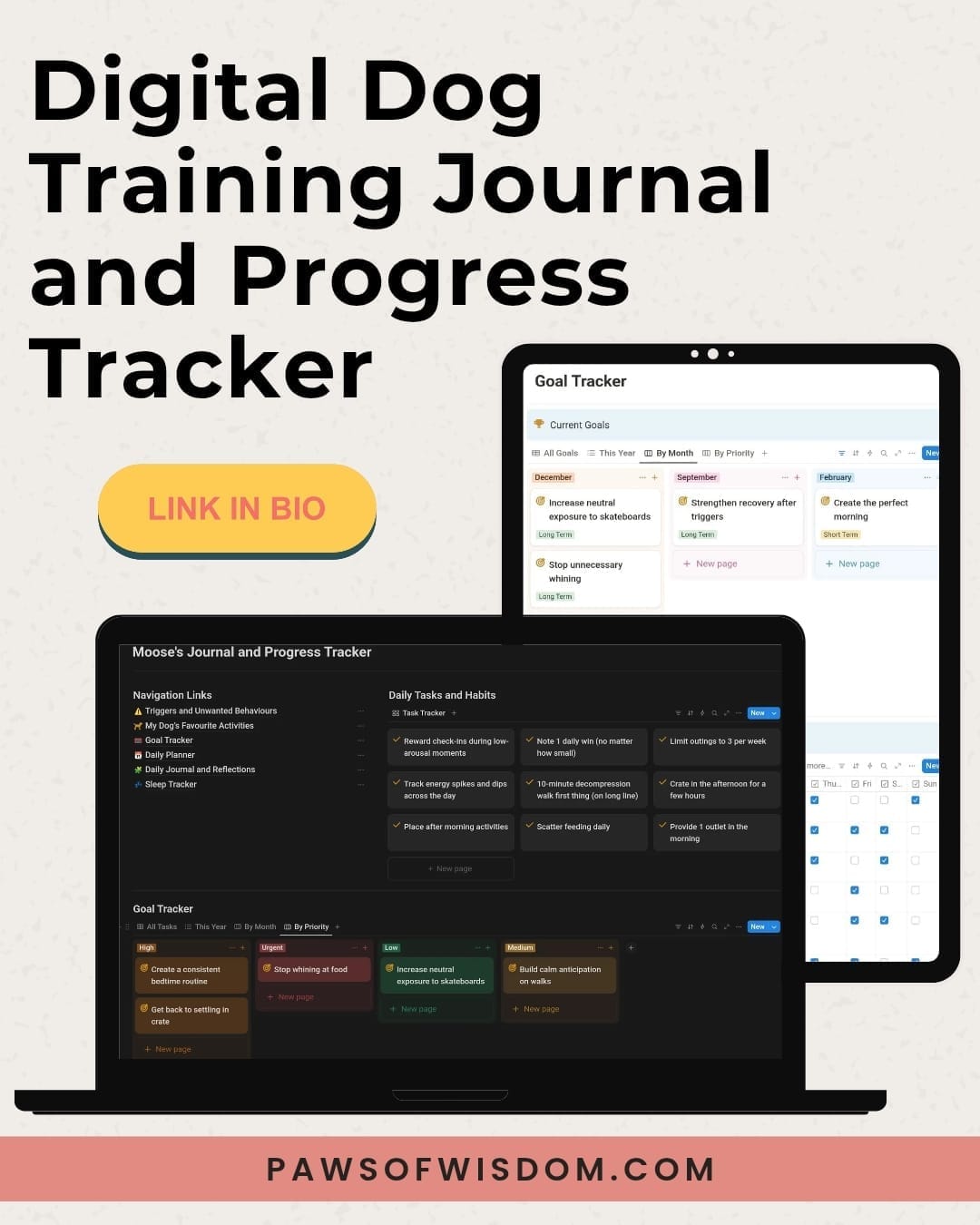Teaching A Dog to Regulate: Helping Reactive Dogs Find Calm
If you’re exhausted from constantly managing your reactive dog’s hyperactivity, stress, overarousal, restlessness and relentless pacing — join the club!
I was stuck in the same frustrating daily loop for so long with my own reactive dog, Jasper. The thing is, dogs like ours often seem trapped in this cycle of stress, arousal, and endless energy, and it can feel impossible when it comes to teaching a dog to regulate their emotions, internal state and energy so they can actually just relax.
Now, what a lot of people don't realise (it took me a while too), is that reactivity isn’t just a training issue — it’s a regulation issue. It’s not about more commands or stricter obedience. It’s about helping your dog learn how to manage their internal state.
Learning internal regulation gives your dog the ability to handle stress and frustration naturally, and gives you a break from the constant chaos.
In this blog post, I’ll walk you through why regulation is so often overlooked for reactive dogs, the foundational steps that make it possible, and exactly how to get started. I’ll also share real-life examples from my routine with Jasper, common mistakes to avoid, and helpful resources to keep you on track.

The Importance Of Regulation
Regulation isn’t just a “nice to have” — it’s a crucial piece of the foundation that makes everything else possible.
A dog who is rested and regulated is easier to train, more emotionally balanced, and better able to think, focus, and cope with challenges.
On the flip side, a dog stuck in stress mode struggles with impulse control, feels constantly overwhelmed, and reacts out of frustration or fear.
The difference between “stressed out” and “regulated” doesn’t come from pushing harder and adding more to their plate — it comes from supporting your dog’s nervous system. That’s why teaching regulation isn’t optional for reactive dogs — it’s essential.

Why Reactive Dogs Struggle to Regulate
Reactive dogs often battle with what I call the Unholy Trinity: stress, frustration, and arousal.
These internal states aren’t bad or abnormal, in fact, every dog experiences them. But for reactive dogs, the issue isn’t the presence of these emotions. It’s the lack of regulation.
Without the ability to come back down from frustration and arousal or decompress after stress, everything starts to stack — leading to chronic overwhelm, stress, impulsive behaviours, and reactive outbursts that seem to come out of nowhere.
Many of these dogs start living life in a constant state of fight-or-flight. They’re hyperaware, on edge, tense, anticipating and unable to settle even in calm environments.
What makes it worse? Inconsistent routines, poor sleep, unmet needs, and unclear boundaries. Imagine trying to relax when your body’s screaming with tension and you don’t know what’s coming next. That’s what life feels like for a reactive dog without proper regulation skills.
The Holy Trinity: Foundations for Regulation and Calm
Teaching your dog to self regulate isn't just about specific exercises — it's about creating the right foundation that allows your dog to regulate. I like to think of this as the Holy Trinity (see what I've done here) — the three core elements essential for regulation and calm:
Quality Sleep
Good regulation begins with deep, quality sleep and regular decompression. Reactive and anxious dogs often struggle to get proper, high-quality rest, which affects their ability to cope with everyday stress.
Dogs should realistically be sleeping around 16-18 hours, BUT dogs that struggle with life really should be looking at about 18 hours minimum! Because of this, you want to make sure you prioritise and improve sleep, create quiet, safe havens and calming routines, and ensure your dog has downtime throughout the day.
Purposeful Outlets
Every dog has instinctual drives that need fulfilling. Purposeful, breed specific outlets allow your dog to tap into these natural instincts constructively and in a controlled environment and help to reduce stress and frustration.
For example, working breeds benefit greatly from activities such as bitework or scent focused activities, while terriers thrive when provided with digging or something to destroy or chase.
Mental Stimulation
Just like physical exercise, mental stimulation is crucial for creating balance and calm. Activities that challenge and engage your dog's brain, such as puzzle feeders, training sessions, and enrichment games, prevent boredom, can provide relaxation and promote healthy regulation.
Bonus: Structure and Boundaries
While not officially part of the Trinity (although I suppose it could fall under sleep in a way), structure and clear boundaries act as the glue that holds everything together.
Dogs thrive on routine, and when their world is predictable, consistent, and clear.
Establishing routines, boundaries, clear communication, and consistent expectations helps your dog feel secure, and allows them to learn to settle reinforcing their ability to self regulate.
By focusing on these foundationas, you give your dog the best chance at learning and practising effective regulation.

Practical Steps for Teaching A Dog To Regulate
#1 - Start With a Consistent Daily Routine
Dogs thrive on routine and consistency, especially for reactive and anxious dogs. Predictability reduces anxiety, helping your dog feel secure, safe and settled.
Start each day with simple rituals like calm feeding times, predictable toilet breaks, structured walks, and structured downtime like place training.
Over time, these consistent patterns teach your dog when to rest, when it's time to be active, and when to decompress. A routine reduces your dog's need to constantly anticipate what's next.
Additional Tips:
Keep your routine calm and predictable, especially around key stress points (morning, evening, meal times).
Consider keeping a daily log to track your dog's stress patterns, improvements, and setbacks so you can change your routine accordingly.
#2 - Create Dedicated Safe Havens
Designate a quiet, comfortable area of your home where your dog can retreat. This safe haven should always be accessible and free from disturbances. Whether it's a crate, a cosy corner with their bed, or a specific room, ensure it stays calm and inviting. When and if your dog chooses to go to this space, respect their need for quiet time and avoid interrupting (this is why I prefer having this in another quiet room).
Additional Tips:
Add comfortable bedding or blankets (for some comfort makes all the difference).
Play low music from a speaker (reggae and classic rock are great options. There's even a podcast on Spotify called "My dog's favourite podcast!)
Reward calm behaviours when your dog chooses to retreat here voluntarily. I also love putting treats in there when my dog isn't in there, so when he does retreat there's something there for him and he isn't anticipating food reinforcement from me.
#3 - Integrate Decompression Activities into Your Routine
Decompression activities are essential for releasing pent-up stress and lowering arousal levels.
Incorporate daily sniffari walks (leisurely walks that allow plenty of sniffing), scatter feeding in grass or puzzle toys, or sessions with chew toys and lick mats.
Additional Tips:
Scatter feed treats or kibble outdoors to encourage calm, exploratory sniffing. Great for adding to morning and pre-bed routines!
Try rotating decompression activities to keep things interesting for your dog but if you find something that works, there is nothing wrong with sticking with it!!
Schedule these activities after potentially stressful events (like busy walks or vet visits) to help your dog reset.

#4 - Teach Relaxation Cues and Place Training
Sometimes our dogs struggle so much we have to enforce relaxation until it becomes a habit. Teaching specific relaxation cues or place training helps your dog understand when it's time to settle down.
Reward calm, relaxed behaviour frequently, gradually increasing the duration your dog stays settled. With practice, your dog learns to associate these cues or scenarios with feelings of calm and safety.
Additional Tips:
Use medium/high rewards initially, gradually reducing frequency as the behaviour becomes more reliable (don't rely too heavy on these, you don't want to create an anticipation).
Practice frequently and consistently in short sessions throughout the day.
#5 - Prioritise Quality Sleep
Sleep is a crucial part of your dog's ability to battle the Unholy Trinity (stress, frustration, arousal). Ensure your dog gets sufficient, undisturbed sleep by creating an environment that allows rest.
Set regular routines and avoid overstimulating activities just before sleep. Your dog's sleeping area should be quiet (apart from background music if needed), dark, comfortable, and consistent.
Additional Tips:
Invest in calming sleep aids (orthopaedic beds, calming music, crates, calming treats and plug ins etc).
Encourage a quiet household at night — minimise loud noises, lights, or disturbances.
Track sleep quality and duration; adjust routines accordingly if your dog appears restless or overtired.
TL;DR: Teaching a Dog to Regulate (Without Losing Your Mind)
Regulation isn’t optional. A dysregulated dog can’t learn, focus, or settle — no matter how much commands or exercise you throw at them.
The “Holy Trinity” is your foundation: Quality sleep, purposeful outlets, and mental stimulation.
Daily routines = daily relief. Predictability soothes the nervous system and builds safety.
Safe havens and decompression matter. They help your dog come down from stress and reset.
Tracking progress helps you stay sane. Tiny wins add up, but you’ll miss them if you don’t write them down.
Common Mistakes to Avoid When Teaching A Dog To Regulate
#1 - Skipping Decompression and Rest
Many owners dive straight into training or socialisation without first ensuring their dog's needs are met. Without sufficient decompression and rest before this, your dog will more than likely be operating from a baseline of stress, frustration, and overstimulation which will make training near impossible.
Always prioritise calming activities, decompression, adequate rest, and relaxation first before adding training or trying behaviour modification.
What To Do Instead:
Regularly schedule (and enforce if needed) downtime, especially after stressful events.
Notice your dog’s stress signals and proactively provide decompression activities to prevent stacking.
#2 - Inconsistency in Routine and Boundaries
A sporadic or unpredictable daily routine can heighten anxiety in reactive dogs, undermining your training efforts. You don't need a strict routine that you follow by the minute, but dogs do need clear signals and consistency to understand expectations and feel safe.
Without clear guidelines, your dog is likely to become confused, stressed, or even more unpredictable.
What To Do Instead:
Keep main points predictable - feeding times, yuor daily walks, play, and rest.
Ensure all household members follow the same routine and rules to avoid confusion during this period.
#3 - Pushing Too Fast, Too Soon
Teaching regulation is a slow, tedious, methodical process that doesn't happen overnight. Trying to rush results by doing too much or pushing too hard will increase their frustration and stress.
What To Do Instead:
Celebrate the small wins, focusing on incremental progress rather than big leaps.

#4 - Ignoring or Misreading Stress Signals
Misinterpreting or overlooking your dog's stress signals (such as lip licking, yawning, pacing, whining, shaking off, panting, etc) can lead to setbacks.
When you become attuned to subtle body language, you can intervene early, preventing escalation into overarousal or impulsive outbursts.
What To Do Instead:
Familiarise yourself with your dog's stress signals.
Step in early with calming interventions (distance, decompression, redirection, time-outs) when you notice signs of stress.
#5 - Neglecting Mental and Physical Outlets
Regulation isn't just about rest; it’s also about meeting your dog’s needs through outlets and enrichment. Dogs who don't have appropriate channels to release mental and physical energy will struggle more with self-regulation.
Outlets help your dog release the excess tension and frustration, that stops your dog from shutting off.
What To Do Instead:
Provide breed specific outlets regularly (sniffing, chasing, digging, etc.).
Use interactive games, puzzles, challenges and structured play to balance physical and mental stimulation.
If your dog’s constantly “on,” they don’t need more walks — they need better outlets.
👉🏾 [Grab my FREE Breed Specific Outlets Guide] and learn how to work with their instincts, not against them.
Real-Life Example: A Day in Our Regulation Routine
Getting our daily rhythm right took a lot of trial, error, and adjusting expectations (mostly mine). And honestly? It’s still a work in progress, but I’ve learned that consistency matters more than perfection.
So if you’re wondering what this actually looks like in real life, here’s a breakdown of our current routine — not because it’s flawless, but because it works for us. Use it as inspiration...
Morning
We start with a short, structured walk — clear boundaries, calm pace. Then a flirt pole session to release pent-up energy, followed by a decompression period (sniffing, exploring, no commands).
We walk home with the same structure and finish with a scatter feed of breakfast in the garden. After that? He heads to his place position and sleeps until midday. All this takes about an hour.
Midday
Time for what we call the “box of destruction” — cardboard boxes filled with treats or toys he can shred, scavenge, and destroy. It’s messy. And it’s magic.
After that: a gentle massage, a frozen Kong, and quiet time resting in his crate. Nothing flashy. Just reset mode.
Afternoon
This is usually when his arousal starts creeping back up — so we keep it gentle. A bit of structured play, some scentwork, or a food puzzle. Just enough to stimulate his brain without overstimulating his body.
Evening
Dinner is another scatter feed — we take it slow. Then a calm decompression walk, followed by cuddles and a predictable bedtime routine with low sensory input. Dim lights, soft music, slow energy. We wind down together.
🖋 Track and Prevent Overstimulation (Without Overwhelm)
The best way to prevent chaos is to understand your dog’s patterns. My Digital Dog Training Journal lets you track their triggers, routines, and behaviours in one place, so you can spot overload before it happens.
It’s built for real-life dog owners, and it’s helped me spot patterns I would’ve otherwise missed. It’s the perfect companion for reactive and challenging dogs, and helps you see progress more clearly over time!
Still Struggling With Regulation? Try a Stress Detox
If your dog is still struggling to regulate despite your efforts, their nervous system might be stuck in overdrive and when that happens, no amount of training or structure will stick — because their body is too overwhelmed to take it in.
This is where a Detox Protocol can make all the difference.
A dedicated detox period reduces exposure to stress, calms the nervous system, and helps bring your dog back to a workable baseline — the foundation you need before real regulation can begin.
I created a FREE 5-Day Stress Detox Protocol to help you do exactly that.
It’s simple, effective, and designed to gently reset your dog’s system so they can finally start to settle — and stay settled.
Final Thoughts
Teaching a dog to regulate takes time, and that’s okay. It’s not something we can rush.
Some dogs will pick it up quickly. Others may take longer, and that’s okay too. Many reactive dogs are simply overwhelmed, and the real progress comes when we meet them with patience and structure.
By focusing on decompression, consistent routines, restful sleep, and fulfilling their needs, you’re giving your dog the best possible chance to feel safe, calm, and soon regulated.
Remember: Every small win matters. Every calm moment counts.
Frequently Asked Questions (FAQs): Teaching Self Regulation
Typically, improvements appear within a couple of weeks depending how consistent you are. You should be able to notice substantial change within months. If your dog has been stuck in a state of stress then it could take longer. Patience is critical.
No dog is too old but older dogs may take longer if they haven't been used to regulation. Dogs who have been in a prolonged state of stress will also take longer than average.
Daily stress levels, triggers, internal state, and routines influence regulation. This is why understanding your dog's stress signals is beneficial, so you can intervene in the buildup. Consistency is key to sustained calmness.
Just like anything with our dogs, consistency is essential. Daily practice when it comes to decompression will yield the best results for lasting regulation.
Related Reading
A FREE community with downloadable guides and resources, and people who get it.
A simple and structured reset for overstimulated, dysregulated, chaotic dogs.
Simple, clear guidance to help you understand your dog through a regulation-first lens.











